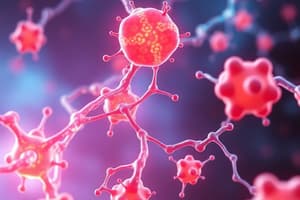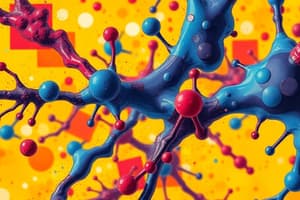Podcast
Questions and Answers
النورأدرينالين هو ناقل عصبي في الجهاز العصبي السمبثاوي.
النورأدرينالين هو ناقل عصبي في الجهاز العصبي السمبثاوي.
True (A)
ما هي الاستقبالات التي تنشط عند تحريض المستقبلات α1؟ (اختر جميع الخيارات الصحيحة)
ما هي الاستقبالات التي تنشط عند تحريض المستقبلات α1؟ (اختر جميع الخيارات الصحيحة)
- انقباض العضلات الملساء (correct)
- زيادة إفراز الأنسولين
- ارتفاع ضغط الدم (correct)
- زيادة إفراز الغلوكاجون (correct)
ما هو تأثير تحريض مستقبلات β1 على القلب؟
ما هو تأثير تحريض مستقبلات β1 على القلب؟
زيادة القابلية للانقباض، وزيادة سرعة ضربات القلب، و تحفيز النقل الأذيني بطيني، و تحفيز الإثارة القلبية.
أي من الأدوية التالية ينتمي إلى مثبطات المستقبلات α غير الانتقائية؟
أي من الأدوية التالية ينتمي إلى مثبطات المستقبلات α غير الانتقائية؟
أي من الأدوية التالية يستخدم لعلاج الصدمات؟
أي من الأدوية التالية يستخدم لعلاج الصدمات؟
أي من الأدوية التالية يثبط الإفراز الحمضي المعدي بشكل غير مباشر؟
أي من الأدوية التالية يثبط الإفراز الحمضي المعدي بشكل غير مباشر؟
ما هي آلية عمل مركبات البنزيديا زيبين؟
ما هي آلية عمل مركبات البنزيديا زيبين؟
أي المخدرات التالية ذات تأثير مسكن أقوى من المورفين
أي المخدرات التالية ذات تأثير مسكن أقوى من المورفين
ما هو الاستعمال الرئيسي لمركبات البنزيديا زيبين؟
ما هو الاستعمال الرئيسي لمركبات البنزيديا زيبين؟
مضادات الالتهاب اللاستيروئيدية تثبط إنزيم COX بشكل مباشر.
مضادات الالتهاب اللاستيروئيدية تثبط إنزيم COX بشكل مباشر.
ما هي أهم أعراض سمية الباراسيتامول؟
ما هي أهم أعراض سمية الباراسيتامول؟
ما هي أهم أسباب حدوث القرحة الهضمية؟
ما هي أهم أسباب حدوث القرحة الهضمية؟
Flashcards
مقلدات الودي
مقلدات الودي
أدوية تحاكي تأثيرات الجهاز العصبي الودي.
حاصر الودي
حاصر الودي
أدوية تمنع تأثيرات الجهاز العصبي الودي.
النور أدرينالين
النور أدرينالين
ناقل عصبي في الجملة الودية يُحرر ليؤثر في الأعضاء.
المستقبلات الأدرينرجية
المستقبلات الأدرينرجية
Signup and view all the flashcards
مستقبلات α1
مستقبلات α1
Signup and view all the flashcards
مستقبلات β1
مستقبلات β1
Signup and view all the flashcards
مستقبلات β2
مستقبلات β2
Signup and view all the flashcards
الأدرينالين
الأدرينالين
Signup and view all the flashcards
الدوبامين
الدوبامين
Signup and view all the flashcards
Phenylephrine
Phenylephrine
Signup and view all the flashcards
Isoprenalin
Isoprenalin
Signup and view all the flashcards
Amphetamin
Amphetamin
Signup and view all the flashcards
Ephedrine
Ephedrine
Signup and view all the flashcards
حاصرات α
حاصرات α
Signup and view all the flashcards
Phenoxybenzamin
Phenoxybenzamin
Signup and view all the flashcards
Prazosin
Prazosin
Signup and view all the flashcards
حاصرات β
حاصرات β
Signup and view all the flashcards
Propranolol
Propranolol
Signup and view all the flashcards
Esmolol
Esmolol
Signup and view all the flashcards
5-HT2
5-HT2
Signup and view all the flashcards
Dopamin
Dopamin
Signup and view all the flashcards
نقص بوتاسيوم الدم
نقص بوتاسيوم الدم
Signup and view all the flashcards
نقل القلبي
نقل القلبي
Signup and view all the flashcards
تأثيرات إيجابية على القلب
تأثيرات إيجابية على القلب
Signup and view all the flashcards
Elevated Blood Pressure
Elevated Blood Pressure
Signup and view all the flashcards
الخلاصة
الخلاصة
Signup and view all the flashcards
Study Notes
Overview of the Study Notes
- This document contains detailed study notes on pharmacology, specifically focusing on sympathomimetic and sympatholytic drugs.
- It covers various aspects like receptors, mechanisms, and clinical uses of different drugs.
- It also includes the adverse effects and contraindications of each drug.
Sympathomimetic Drugs
- Direct-Acting Sympathomimetics:
- Affect adrenergic receptors directly
- Examples include epinephrine (adrenaline) and norepinephrine (noradrenaline), Phenylephrine, Isoprenaline
- Ephinephrine/Epinephrine:
- A catecholamine released from the adrenal medulla
- Directly stimulates alpha and beta receptors
- Cardio-effects: Increased contractility, heart rate, and AV nodal conduction速度, increased cardiac output
- Vascular effects: Constricts blood vessels in skin, mucous membranes and visceral organs, dilates blood vessels in skeletal muscles
- Other effects: Dilates the bronchioles , dilates pupil, increases blood clotting ability
- Used therapeutically for acute asthma attacks, anaphylactic shock, cardiac arrest, terminating certain supraventricular tachycardias and local vasoconstriction
- Adverse effects depend on dose and can include anxiety, fear, tension, headache, tremor and/or cardiac arrhythmias
- Contraindications: conditions such as shock, hypertension, hyperthyroidism
- Phenylephrine:
- Direct alpha-1 agonist
- Used for nasal decongestants, mydriasis
- Isoprenaline:
- Non-selective beta agonist
- Used for bradycardia(slow heart rate), AV block, cardiac arrest
- Adverse effects can include hypotension, angina
- Indirect-Acting Sympathomimetics:
- Release norepinephrine from storage, increasing its effects on receptors
- Examples include amphetamines
- Mixed-Acting Sympathomimetics:
- Release norepinephrine and directly stimulate alpha and beta receptors
- Examples include ephedrine
- Other sympathomimetics including: Dopamine, Dobutamine, Isoprenaline/Isoproterenol, Salbutamol, Terbutaline, Pirbuterol, Albuterol, Fenoterol, Soterenol, Isoxsuprin, Ritodrin, Etilefrin
Sympatholytic Drugs (Adrenergic Antagonists)
- Alpha-Blockers:
- Non-selective alpha-blockers: Phenoxybenzamine, Phentolamine
- Used in hypertension and pheochromocytoma
- Adverse effects: orthostatic hypotension, dizziness, nasal congestion
- Selective alpha-1 blockers: Prazosin, Terazosin, Doxazosin, Tamsulosin, Alfuzosin
- Used in hypertension, benign prostatic hyperplasia (BPH), and Raynaud's phenomenon
- Adverse effects: orthostatic hypotension, dizziness, headache
- Non-selective alpha-blockers: Phenoxybenzamine, Phentolamine
- Beta-Blockers:
- Nonselective beta-blockers: Propranolol, Nadolol, Timolol, etc.
- Impact beta 1,2 receptors
- Cardioselective beta-blockers: Metoprolol, Atenolol, Bisoprolol, etc.
- Primarily affect beta-1 receptors
- Beta-blockers with intrinsic sympathomimetic activity: Pindolol, Acebutolol, etc.
- Limited beta receptor blockade
- Nonselective beta-blockers: Propranolol, Nadolol, Timolol, etc.
- Uses, considerations, and adverse effects: ( vary based on specific med and receptor selectivity)
- These drugs are used to counteract effects of SNS stimulation
- Their uses include hypertension, cardiac arrhythmias, angina, migraine, tremor
- Important Considerations:
- Selective vs. non-selective beta-blockers: This distinction is vital for tailoring treatment to specific needs. Non-selective blockers can have adverse effects on airways.
- Beta-blockers' effects on other systems (e.g., respiratory): Beta-blockers can affect breathing, especially nonselective ones, and should be used cautiously, in patients with asthma or COPD.
Additional Drugs and Concepts
- Anticholinergics: These block muscarinic receptors, with diverse applications.
- Cholinesterase Inhibitors: These prevent the breakdown of acetylcholine, increasing its effects.
- Analgesics (Pain Relievers): Central and other types mentioned.
- Muscle Relaxants: These act on the central nervous system, not the neuromuscular junction, to reduce muscle spasms.
- NSAIDS: Nonsteroidal anti-inflammatory drugs, impacting COX enzymes.
- Other Drugs: Specific drugs and treatment contexts are highlighted. General principles of adverse effects, interactions, and contraindications are presented.
- Important Note: This is a summary and detailed information, including indications, dosages, adverse effects, and specific uses, should be reviewed in a medical textbook or consult with a medical professional before using this information to treat any medical condition.
Studying That Suits You
Use AI to generate personalized quizzes and flashcards to suit your learning preferences.




